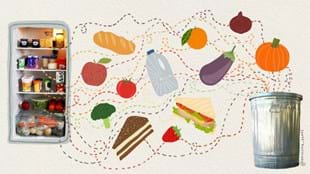Have we gone collectively mad? We live in a world in which one billion people go hungry, yet one in which we throw out 1.6 billion tons of food each year, and where a third of the food produced and prepared globally doesn’t even make it from farm or factory to fork. In some countries the statistics are even more alarming; it’s estimated that in the US, 40 percent of the food grown and produced goes to waste.
Food is lost or wasted throughout the very complicated food supply chain. Some of it may be due to problems in harvesting, storage, packing, transport, but about one third of edible food wastage globally occurs before it leaves the farm gate, and about one fifth on our plates or in our refrigerators.
It is an ethical issue, and an environmental issue. Wasted food means wasted resources – the fossil fuels, water, fertilizer, labor and financial capital used to produce it. There are also the greenhouse gases that are produced at every stage of the food chain, including the methane emitted when organic matter is dumped in the global rubbish tip. According to the United Nations Food and Agriculture Organization (FAO), food waste is responsible for roughly eight percent of global emissions.
The United Nation's Sustainable Development Goals has set a target of halving food loss and waste by 2030, but a recent report by the Boston Consulting Group (BCG) says the global response to food waste is fragmented and inadequate. Unless things change radically, there’s little chance of achieving that target.
As the report points out, to put that 1.6 billion tons of food waste in perspective, it’s equivalent to the mass of Manhattan. The report estimates that annual food loss and waste is likely to rise by a third by 2030, with 2.1 billion tons, worth $1.5 trillion, being lost or thrown away, equivalent to 66 tons per second. Proposed solutions include better supply chain efficiency, changing supply chain infrastructure, developing industry standards and legislation that reduce rather than incentivize waste.
Annual food loss and waste is likely to rise by a third by 2030, with 2.1 billion tons, worth $1.5 trillion, being lost or thrown away.
Individual consumers can play their part too. We could, for instance, demand more ugly fruit and vegetables. No, seriously! A study published by the University of Edinburgh this year found more than 50 million tons of fresh produce grown across Europe is thrown out each year, mainly because it doesn’t meet consumer expectations of how it should look. As one of the authors has said: “The scale of food that is wasted when it is perfectly safe to eat is shocking at a time when one-tenth of the world’s population is perpetually underfed.”
How did we get so wasteful? The farmers blame the supermarkets, and their demand for fruit and vegetables that conform to a certain shape and size. The supermarkets blame consumers, who turn their noses up at those two-pronged carrots and misshapen potatoes. Perhaps many of us don’t know what fruit and vegetables look like in the real world – in the ground, on a tree – but we could learn.
The French supermarket chain Intermarché launched its “Inglorious Fruits and Vegetables” campaign in 2016, offering imperfect produce at a 30 percent discount. France was also the first country, in 2016, to introduce a law requiring supermarkets to donate their food waste to charity rather than throw it out.
An increasing number of businesses are recognizing the economic and environmental advantages (and marketing opportunities) of reducing or repurposing food waste.
Supermarket giant Carrefour is promoting awareness of the importance of using leftover food through an anti-waste restaurant in Taiwan, serving dishes made from unsold food items. UK retailer Tesco is converting unsold baked goods into animal feed and oil waste into biodiesels. It has also experimented with a “Buy One Get One Free – Later” program that allows customers to pick up a free product when they actually need it, rather than stocking up on discounted products that are likely to go off before they’re consumed.
There are also (and likely to be more) technical innovations aimed at consumers, such as smart fridges that alert us to food nearing is use-by date, and smart bins that monitor what we throw out.
But do we really need technologies to save us, and the environment, from our modern (and developed-world) excess? Or could we teach ourselves, become more aware of food, how much we actually need and waste, start buying less of it, and throwing less of it out?
What can we do to reduce food waste?
- Buy less, use what you buy, and get creative with your leftovers. The Guardian has collected a number of novel recipes and ideas.
- Fresh is not always best; frozen food products often retain more nutrients than fresh items, especially “fresh” food that has been shipped from the other side of the world.
- Avoid deals that encourage you to buy more than you need.
- Remember what tends to go off before you eat it; a whole lettuce on its stem, for instance, is likely to last longer than a bag of leafy greens.
- Learn to love and seek out imperfect fruit and vegetables – cut and quartered, you won’t know the difference.
- Brush up on your storage know-how; why you should keep your bananas out of the fruit bowl, why you shouldn’t store your spuds with the onions, etc. This quick guide from the University of California is a good place to start.
If you want more health and fitness inspiration simply sign up to Fit Planet and get the freshest insights and advice straight to your inbox.







